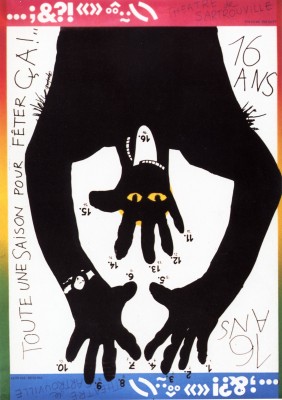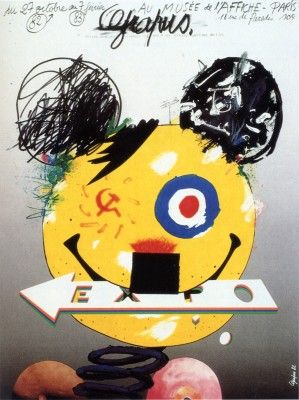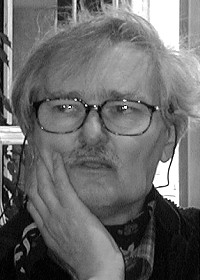|
When Pierre Bernard received the Erasmus Prize 2006 of 150'000 Euro in November 2006, the Erasmus
Foundation also commissioned and financed a book about Pierre Bernard to be written by dutch design researcher Hugues Boekraad.
Maybe they were not aware that an excellent 300 page book (The Master of Design: Pierre Bernard, edited by Jianping He, Singapore 2006) had just been published.
As I began reading the new book, I first thought that I had a defective copy: The introductory pages are missing, and the book starts directly with the description
of a poster "l'enfant dans la societé industrialisée", that uses a photo of Bernard's daughter. The text for the second poster in the book points to
Pierre Bernard's stay in Poland in the studio of Henryk Tomaszewski in 1964-1965, and the obvious polish influence seen in Bernard's theater posters.
On page 11 is a poster with a picture of Pierre Bernard. The famous Micky Mouse poster for the first Grapus exhibition at the
Musee de l'Affiche in Paris is attributed to Bernard.

1976, l'enfant dans la societé industrialisée, p.3 |

1981, poster for the 16. anniversary of the Theatre de Sartrouville, p.4 |

1982, poster for a Grapus exhibition at the Musee de l'Affiche, Paris, p.15 |
Now Pierre Bernard had been a founding member of the influential french group Grapus (1970-1990), which had always
acted as a collective, all their posters are signed "Grapus" to indicate that none of their work could be traced to any particular individual.
Having read sofar, I was wondering, if Grapus finally had given up that fiction, and the book would reveal who actually did what.
That would be a radical departure from their philosophy, and would, or should, certainly be mentioned in the book. I was now in
definite need of an introduction, or summary, or table of content, and searched for it at the end of the book, in vain. A marvel of book design :(
Finally, I located on page 33 a "preface" by Pierre Bernard, expressing his hope that his comrades would not take the title of the book as
a cynical joke, but as an expression of gratitude, and lists all the people that participated in Grapus, and later in the studio "Atelier de Creation Graphique"
that he founded in 1991, a veritable Who's Who of graphic design in France. Some names are missing, most notably that of Vincent Perrottet:
Grapus: Gerard Paris-Clavel, François Miehe, Jean-Paul Bachollet, Alexander Jordan,
Maria Arnold, Christine Baillet, Rik Bas Baker, Joseph
Balette, Lindsay Bartolini, Dirk Behage, Geneviève
Bentolila, Claude Benzrihem, Leslie Blum, Paul-André
Bungelmi, Gérard Delafosse, Evelyne Deltombe, Eszter
Dôme, Marc Dumas, Anne Castebert, Mathieu Csech, Anne
Dasriaux, Annie Demongeot, Ibrahim Denker, Pierre Di
Sciullo, Fokke Draaijer, Sylvain Enguehard, François
Fabrizi, Richard Ferrand, Gérard Gaillard, Anne Gallet,
Valérie Gandon, Jean-Louis Gigue, Sylvia Goetze, Michèle
Guieu, Claire Herlic, Denis Imbert, Richard Ferrand, Alain
Lebris, Martin Le Chevalier, Patricia Lemorvan, Annette
Lenz, Martine Loyau, Malte Martin, Pierre Milville, Annick
Orliange, Muriel Paris, Claire Prébois, Marjolaine Preiss,
Michel Quarez.Michel Robledo, Alain Roth, Thierry Sarfis,
Théa Sautter, Ivan Sigg, Cornélia Staffelbach, Elian Stephan,
Jean-Luc Soulier, Chantai Sueur, Pierre-Laurent Thève,
Michel van der Sanden, François Vannière
Atelier de Creation Graphique:
Fokke Draaijer, Dirk Behage,
Fabienne Benoît, Johannes Bergerhausen, James Bolton,
Stéphanie Brunel, Lucille Clerc, Cyril Cohen, Antoine
Corbineau, Chantale Danjon, Julie de la Celle, Guillaume
Chavanne, Béatrice Delas, Virginie Démonio, Anne Drucy,
Sylvain Enguehard, Richard Ferrand, J ustine Gaxotte,
Isabelle Guillaume, Luc Guinguet, Nicolas Haeberli, Boris
Igelman, Milène Joume, Ofer Kahana,, Agnes Korink,
Jacqueline Kubler, Ohyun Kwon, Thomas Lélu, Livio Loïal,
Sébastien Marchai, Fanette Mellier, Sophia Païva-Raposo, '
Pierre Péronnet, Grégoire Romanet, Kathleen Rousset,
Johannes Ruesch, Julien Samani, Milena Scharer, Bianca
Sistermans, Dominique Soubranne, Laurent Stosskopf,
Frédéric Teschner,Karin Tragenap, Wijntje Van Rooijen,
Jeanne Verdoux.
At this point, I received the following email from infos@lafraternellegrapus.fr, essentially asking
to change most copyrights and attributions in the book from "Pierre Bernard" to "Grapus":
Communiqué de la Fraternelle Grapus
L'information ci-dessous a été diffusée au Centre Pompidou
à l'occasion de la Revue parlée "Pierre Bernard, 2006 : Prix Érasme",
le 7 novembre 2007, par la Fraternelle Grapus.
Pour insertion dans le livre concerné, affichage ou publication.
Errata
Dans le livre, Mon travail ce n'est pas mon travail,
publié à l'occasion du Prix Érasme attribué à Pierre Bernard,
Lars Müller publishers, Baden (Suisse), 2006,
page 6, au lieu de lire : Bernard, page 9, au lieu de lire : Bernard, page 13, au lieu de lire : Bernard, page 14, au lieu de lire : Bernard, page 17, au lieu de lire : Bernard, page 18, au
lieu de lire : Bernard, page 25, au lieu de lire : Bernard, page 81, au lieu de lire : Bernard, page 105, au lieu de lire : Bernard, page 106, au lieu de lire : Bernard, page 118, au lieu de
lire : Bernard, page 121, au lieu de lire : Bernard, page 133, au lieu de lire : Bernard, page 161, au lieu de lire : Bernard, page 174, au lieu de lire : Bernard, page 188, au lieu de lire :
Bernard, page 218, au lieu de lire : Bernard, page 219, au lieu de lire : Bernard, page 299, au lieu de lire : Bernard, il faut lire : groupe Grapus.
Dans le colophon, au lieu de lire : © 2006 images Pierre Bernard,
il faut lire : © 2006 images groupe Grapus
pour les page 3, page 4, page 7, page 8, page 11, page 12, page 15, page 16, page 19, page 20, page 24, pages 38-39, pages 44-45, pages 50-51, pages 56-57,
pages 62-63, page 83, pages 84-85, pages 86-87, pages 88-89, pages 90-91, pages 92-93, page 94, page 96, pages 98-99, page 107, pages 108-109, pages 110-111,
pages 112-113, pages 114-115, page 119, page 120, pages 122-123, pages 124-125, pages 126-127, pages 128-129, page 131, page 132, pages 134-135, pages 136-137,
page 141, pages 142-143, pages 144-145, pages 146-147, page 163, page 177, pages 178-179, pages 180-181, pages 182-183, pages 184-185, page 189, page 190,
pages 192-193, pages 194-195, pages 196-197, pages 198-199, page 221, pages 222-223, pages 226-227, page 228, page 298, page 300.
To get more clarity about the situation, I asked some of the key players in this drama for comments, and would like to thank those that answered:

Pierre Bernard, subject
|

Hugues Boekraad, author |

Lars Mueller, publisher |

Erasmus of Rotterdam, humanist |

Alex Jordan |

Vincent Perrottet |

Gerard Paris-Clavel |

Jean-Paul Bachollet |
It turned out that "Fraternelle Grapus" is an association of former Grapus members and others interested in the Grapus estate, many of whom
are happy that their former colleague received
such a prestigious prize, but are unhappy about the distribution of the money, and in particular about Bernard's claim of copyrights
for their common work. Most comments expressed the hope that the activities of the whole Grapus group would be documented soon in a historic
perspective and all their work be presented together in a suitable way. Personally, I would also enjoy an account of the mechanisms
of collective creation, the group dynamics, the political history, the reasons of the dissolution, the individuals,
the role of the temporary members and stageaires, in short the "true story" about Grapus.
The current controversy about the book distracts a bit from its values, it is well researched, clearly written, full of details and pictures,
and a large part of it deals with Bernard's equally impressive post-Grapus work.
|











